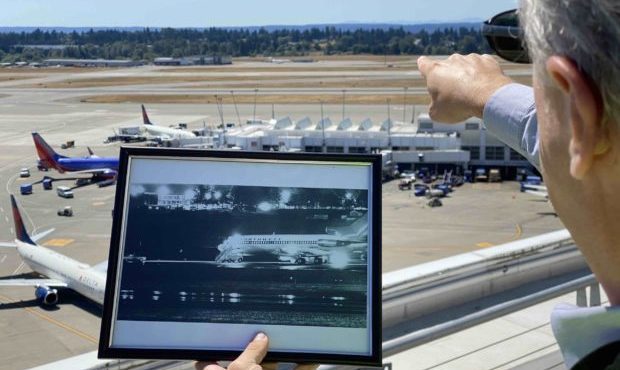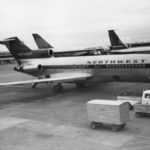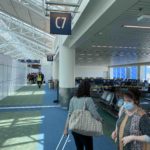Searching for D.B. Cooper ‘historic sites’ in Portland and Seattle
Sep 22, 2021, 8:56 AM
With the 50th anniversary of the infamous D.B. Cooper hijacking coming up this Thanksgiving Eve, the places where the crime played out – airports in Portland and Seattle – still hold physical traces that stir the memories of what transpired on a dark and stormy Pacific Northwest night five decades ago.
For those who may not remember, “D.B. Cooper” is what the media called the unknown hijacker who got on a Northwest Airlines 727 in Portland on the afternoon of Nov. 24, 1971. En route to Seattle, the man, who’d actually given his name as Dan Cooper, told a flight attendant he had a bomb. They landed at Sea-Tac Airport, where Cooper received $200,000 in cash and four parachutes in exchange for the 35 passengers. The plane took off again and headed south. Somewhere over southwest Washington, Cooper jumped out of the backdoor of the jet and was never seen again.
There have been so many theories about who D.B. Cooper really was, and so many people have come forward claiming he was a relative or friend. Fifty years on, interest in the unsolved mystery has ebbed somewhat with the passage of time, but still, the search for Cooper continues; a researcher is even at work this autumn, trying to find money from the hijacking along the Columbia River (where thousands of Cooper dollars turned up in 1980).
But putting all the theories and unproven conjecturing aside, Portland International Airport and Seattle-Tacoma International Airport are the only two places where the existence of D.B. Cooper – or whatever his real name was – can actually be confirmed, and where the only concrete history might still remain.
Kama Simonds is a Port of Portland spokesperson. On a recent visit to Portland International Airport, Simonds shared with KIRO Radio a series of old maps and aerial photos of the Portland airport from 1971.
“This is the terminal roadway that comes up here in front, and you can almost see there was a little bit of parking right in front, … obviously not something we do now,” Simonds told KIRO Radio. “But then you enter the building, and this was the ticket lobby wall. So, back in the day, you could come in and buy a ticket here.”
And that’s exactly what D.B. Cooper did on Nov. 24, 1971: He paid $20 cash for a ticket to Seattle, and then walked to the gate with no security screening. Since no vehicle associated with Cooper was ever identified, nobody knows how he got to the Portland airport 50 years ago – cab? bus? on foot? – but he it’s safe to say that he probably didn’t take advantage of that convenient parking.
“What we’re looking at here is a schematic of the airport as it was back in 1971,” Simonds continued, pointing to a diagram and explaining the layout of PDX 50 years ago. “And if you’re looking at it from the sky, it shows, essentially, the two concourses in a Y-shape, the either sides of the Y, and they come down to the main terminal, that’s in the middle.”
“You can see the Northwest Airlines flights were out of this Concourse L,” Simonds said.
Concourse L was right off the main terminal, and on Nov. 24, 1971, Flight 305 boarded from Gate 52, which was just the second gate down the concourse from the main terminal.
For anyone more used to trekking to the North Satellite at Sea-Tac via escalators, a subway ride, and then more escalators, re-creating Cooper’s walk from ticket counter to gate is a somewhat stunning experience. It was just a few hundred yards at most.
Because of construction underway in 1971, Flight 305’s passengers went down to the lower level of the gate and onto the tarmac, and then boarded the 727 via the built-in stairs in the rear door of the jet.
Unfortunately for purists or historic preservation enthusiasts, Concourse L is gone. In its place is Concourse C, so the closest spot to the “D.B. Cooper Gate” – if anyone wants to make a pilgrimage while in the Portland airport – would probably be Gate C7.
There’s no tourist maps or directional signage indicating this fact, of course. Hijacking is a crime, and Cooper endangered the lives of nearly 40 people. But, five decades later, it’s no stretch to say that the hijacking is a significant cultural moment in Northwest history and, really, American history.
Since Portland prides itself on being famously “weird,” is it weird enough to have a historic plaque at the airport for D.B. Cooper?
“There’s not a plaque,” Simonds said. “There’s a lot of aviation myth and lore around it. … It’s one of those cases that hasn’t been solved. And I think that’s what keeps the intrigue alive.”
Still, Simonds says, D.B. Cooper and what he did are nothing to commemorate at an airport.
“He’s still a criminal, he did something illegal,” Simonds said. “So I think we would be more likely to celebrate some of the amazing aviation pioneers.”
The Portland chapter of the incident came to a close when the 727 took off around 3 p.m., and it was not long after that the actual hijacking began, with a note from Cooper handed to a flight attendant, and a series of communications outlining his demands and threats. Next stop, after the short flight from Portland and then nearly two hours of flying around in a holding pattern north of Seattle, was Sea-Tac Airport. The plane touched down around 5:45 p.m.
At Sea-Tac, D.B. Cooper never actually set foot in the airport, of course. The 727 was parked far from the terminal – after all, he did say he had a bomb in his briefcase – and Cooper stayed on the plane while he waited for the money and parachutes before releasing the passengers, and then waited a bit longer as the jet was refueled.
Like Portland’s airport, Sea-Tac has undergone multiple phases of major construction in the past 50 years, so it’s a little tricky to find the spot where the 727 was parked on Thanksgiving Eve 1971.
Fortunately, an iconic photo of the plane during the Sea-Tac phase of hijacking was taken by Bruce McKim for the Seattle Times. The photo was probably taken via zoom lens from a spot on the old outdoor observation deck at Sea-Tac, which no longer exists. In the image, the 727 is visible, parked on a concrete area, with a portable staircase at the front left side door. A few vehicles are visible nearby, and, to the rear, a fence and a distinctive building are seen in the near distance.
Port of Seattle aviation spokesperson Perry Cooper – no relation to D.B., he jokes – got help from a longtime Port of Seattle staff member to narrow down the location of the 727 and to identify the building visible in the old photo by Bruce McKim.
The building is Prince of Peace Lutheran Church, which still stands west of the airport, but is now completely obscured by trees. Also, the zoom lens likely contributes to the church appearing in the photo to be much closer to the parked jet than it actually is in real life.
On a drive with Perry Cooper around the tarmac at Seattle-Tacoma International Airport, he steered as close as he safely and legally could to the “D.B. Cooper parking spot” – at the south end of what’s now the center runway.
“What we’re understanding is that they would have landed on what is now our center runway and it would have come down to the connection between a taxiway in the very end and the tail, south end of that runway,” Perry Cooper told KIRO Radio. “So, at the time it was 34-Left, or 16-Right. And right now, it’s now the center runway, since we’ve added the new runway to the west.”
The Sea-Tac phase of the hijacking concluded as the 727 took off again around 7:40 p.m. and headed south. Aboard was D.B. Cooper, the flight crew, and one flight attendant, but Cooper wouldn’t remain a passenger for long. When the jet landed in Reno, he was gone.
There are at least two more spots at Sea-Tac related to the hijacking, if not directly connected to D.B. Cooper. One is the Northwest Airlines Lounge where the passengers and two of the flight attendants were taken by bus once they were released from the jet. That lounge was in the B Concourse and is now long gone.
The other spot is Gate A-4. That’s where Flight 305 was supposed to have unloaded its passengers had there not been a hijacking. Perry Cooper says there is no plaque there; but, he says, gate commemorations are not out of the question, they’re just limited to non-criminal activities.
“We have the Sleepless in Seattle gate,” Cooper said. “That is N-7. We actually had a celebration when that closed during construction for North Satellite modernization, and we actually reached out to the film company and they allowed us to use a photo of Meg Ryan and Tom Hanks.”
As for any celebrations related to the 50th anniversary of the 1971 hijacking, it’s clear that the Port of Seattle has no plans to reach out to the producers of The Pursuit of D.B. Cooper for images of Treat Williams or Robert Duvall.
Editor’s Note: An alternate version of this story first appeared in COLUMBIA, the quarterly magazine of the Washington State Historical Society, for which Feliks Banel serves as editor.
You can hear Feliks every Wednesday and Friday morning on Seattle’s Morning News, read more from him here, and subscribe to The Resident Historian Podcast here. If you have a story idea, please email Feliks here.



















